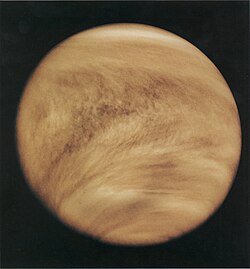Difference between revisions of "Translations:AY Honors/Stars/Planet characteristics/2/en"
m (FuzzyBot moved page Translations:Adventist Youth Honors Answer Book/Stars/Planet characteristics/2/en to Translations:AY Honors/Stars/Planet characteristics/2/en without leaving a redirect: Part of translatable page "Adventist Youth Honors Answer Book/Stars/Planet characteristics") |
(Importing a new version from external source) |
||
| Line 1: | Line 1: | ||
===Venus=== | ===Venus=== | ||
[[Image:Venuspioneeruv.jpg|thumb|250px|right|Venus]] | [[Image:Venuspioneeruv.jpg|thumb|250px|right|Venus]] | ||
| − | Venus is the second-closest planet to the Sun, orbiting it every 224.7 Earth days. After Earth's Moon, it is the brightest object in the night sky. | + | Venus is the second-closest planet to the Sun, orbiting it every 224.7 Earth days. After Earth's Moon, it is the brightest object in the night sky. Venus is one of the four terrestrial planets, meaning that, like the Earth, it is a rocky body. In size and mass, it is very similar to the Earth, and is often described as its 'twin'. The diameter of Venus is only 650 km less than the Earth's, and its mass is 80% of the Earth's. However, conditions on the Venusian surface differ radically from those on Earth, due to its dense carbon dioxide atmosphere. The enormously CO<sub>2</sub>-rich atmosphere generates a strong greenhouse effect that raises the surface temperature to over 400 °C. This makes Venus' surface hotter than Mercury's, even though Venus is nearly twice as distant from the Sun and receives only 25% of the solar irradiance. |
Latest revision as of 22:25, 8 September 2021
Venus
Venus is the second-closest planet to the Sun, orbiting it every 224.7 Earth days. After Earth's Moon, it is the brightest object in the night sky. Venus is one of the four terrestrial planets, meaning that, like the Earth, it is a rocky body. In size and mass, it is very similar to the Earth, and is often described as its 'twin'. The diameter of Venus is only 650 km less than the Earth's, and its mass is 80% of the Earth's. However, conditions on the Venusian surface differ radically from those on Earth, due to its dense carbon dioxide atmosphere. The enormously CO2-rich atmosphere generates a strong greenhouse effect that raises the surface temperature to over 400 °C. This makes Venus' surface hotter than Mercury's, even though Venus is nearly twice as distant from the Sun and receives only 25% of the solar irradiance.

